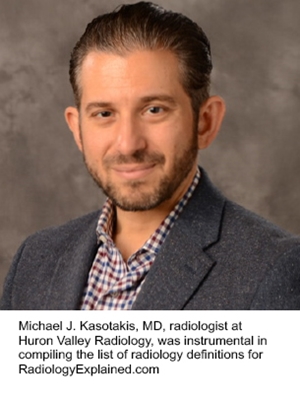- Recognizing a need, a radiologist leads an effort to create an online glossary of imaging terminology for patients.
- Huron Valley Radiology (HVR) now owns and manages the site, which includes definitions for more than 1,000 radiology terms commonly found in imaging reports.
- HVR includes a link to RadiologyExplained.com at the bottom of each of its imaging reports, which contributed to the website’s nearly 22,000 unique visitors in 2018.
 In 2015, Oneil Lee, MD, PhD, learned that his father had gastric cancer. As treatment and countless imaging procedures ensued, Lee’s father had many questions and concerns about his care and the language that radiologists used to describe his imaging results. He spent hours Googling medical terminology without gaining much clarity.
In 2015, Oneil Lee, MD, PhD, learned that his father had gastric cancer. As treatment and countless imaging procedures ensued, Lee’s father had many questions and concerns about his care and the language that radiologists used to describe his imaging results. He spent hours Googling medical terminology without gaining much clarity.
When his father approached him with questions about his imaging results, Lee walked him through the terminology. “It was then that it hit me: My father isn’t alone,” says Lee, then a member of the Huron Valley Radiology (HVR) group in Michigan. “Thanks to the electronic health record, patients have more access to medical reports, but for most of them, medical terminology is like a different language.”
With this realization, Lee envisioned an open-access website of radiology terminology to help patients better understand their imaging reports. Lee approached his friends Michael J. Kasotakis, MD, radiologist at HVR, and Chan H. Park, MD, radiologist at Kaiser Permanente in California, about developing such a resource.
Both Kasotakis and Park were eager to participate. “When I read mammograms and diagnostic images, I often talked to the patient and explained the medical terms in common language,” Park says. “So when Dr. Lee approached me, I was happy to help with the project. I saw this as something that would be a great benefit to patients.”
Featuring more than 1,000 radiology terms to date, RadiologyExplained.com has served nearly 22,000 unique visitors from around the world. “It is essential that patients have a better understanding of what they are dealing with when it comes to their own images. Having that understanding can help ease their anxiety and connect them to the care plans they need. I thought this might be a way to help them understand and empower them in their care,” Lee says.
Developing Content
When the team started developing the website in 2015, its first step was to determine which terms to include on the site. In doing so, Lee, Kasotakis, and Park each focused on a body area that correlated to his specialty: Lee focused on abdomen and pelvis, Kasotakis focused on neuro, and Park focused on breast and chest. Each compiled a list of related terms that non-radiologists might have difficulty understanding, like amyloidosis or adenocarcinoma.Lee developed his abdomen/pelvis terms by combing through sample reports and attempting to read them as if he had no medical training. He even consulted his wife about terminology. She reviewed reports without patient identifiers, and they discussed how a non-radiologist might interpret the language.
Over the next year, the team met every few weeks over Skype or phone to discuss the terms and come to a consensus on each definition. They spent Saturdays and evenings working through the definitions to ensure they were in the simplest language possible.
Some terms were more challenging to define than others. For example, the true definition for aneurysm is difficult to describe, so the team decided to use visual imagery, asking patients to imagine the tip of a balloon that had been over inflated. “A picture is worth a thousand words, as they say, and we thought this kind of visualization would help the patient understand the concept,” Kasotakis says.
 Going Online
Going Online
By the end of the year, the team had compiled approximately 1,000 terms and was ready to move the database online. With little web design experience, Lee purchased a website template that he felt was the most user-friendly and cost-efficient platform for the project. After Lee customized the template, he worked with Kasotakis and Park to add their terms and definitions to the site. To make it easy for patients to navigate the terms in correlation with their imaging reports, the team organized the site by body area: abdomen and pelvis; bones and joints; breast, chest, head, and brain; and neck, spine, and miscellaneous. “Typically when you have a radiology exam, it is on one section of the body,” Lee says. “Organizing the site in this way increases the likelihood that patients will have access to all the terms related to their specific scans.”
The team named the website RadiologyExplained.com, and took it live in late 2015. Before the team even began to publicize the website, 475 unique users visited it in the first two months.
Approaching the Board
After the website was up for a few months, the group began considering ways to expand its presence. “It became clear to us that for this to go to the next level, we needed a professional web designer and endorsement from a hospital group,” Lee says. “Without support, it was becoming difficult to scale due to time commitments and financial constraints.”Lee and Kasotakis presented the group’s work to HVR’s board with the hope that the practice would help finance the website and connect it to a larger patient population. “Our mission was not to make money or to go public,” Kasotakis says. “Our mission was to help patients understand healthcare reports and engage them in their own care. We knew that having support from a large hospital group would help us to reach more patients.”
During their presentation, Lee and Kasotakis stressed how the website would empower patients. “It fulfills a need for patients who want to take more ownership of their medical care, and it benefits ordering physicians by decreasing the amount of questions patients have about their care,” Lee says. “It’s a win-win.”
The website complements other patient-facing radiology sites like RadiolgyInfo.org, which the ACR and the Radiological Society of North America co-manage. While RadiologyInfo.org focuses on explaining procedures, RadiologyExplained.com defines complicated radiology terminology.
“It didn’t take a lot of selling to the board,” says Jim Knauf, chief operating officer for HVR, who was present at Lee and Kasotakis’s presentation. “Our hospital partner was rolling out their patient portal. As patients were going to have more access to radiology reports, I thought this would be a great tool to assist them in understanding what they were reading.”
Soon after the presentation, HVR agreed to acquire RadiologyExplained.com from Lee, Kasotakis, and Park. The radiologists remained involved with the website and created a committee comprising radiologist liaisons in each specialty represented on the website. The liaisons consulted on and tweaked the terminology until they all agreed on the listed definitions.
Reaching More Patients
 As the website was being reintroduced under the HVR brand, everyone involved agreed that a slight facelift was in order. HVR provided $5,000 to hire a web designer who made the open-access website more visually cohesive and improved the search functionality.
As the website was being reintroduced under the HVR brand, everyone involved agreed that a slight facelift was in order. HVR provided $5,000 to hire a web designer who made the open-access website more visually cohesive and improved the search functionality. From there, Knauf led an initiative to market the platform to referring physicians and patients. He and a team of physician liaisons, hospital employees who work directly with ordering physician practices on customer service matters, distributed informational cards to ordering physician practices. Meant for patients, these cards marketed the website to those undergoing imaging procedures.
The cards ask, “Have questions about terms in your report? We can help!” and direct patients to RadiologyExplained.com for answers. Perforated edges near the bottom of the card also allowed patients to tear the website information into convenient wallet-size cards for easier portability.
This marketing strategy was successful, and more patients flocked to the website. By 2017, traffic had increased to 7,674 unique users. “Doctors’ offices are constantly requesting these cards,” Knauf says. “We mail them out as soon as we get a request. Liaisons always have some in their bags to distribute.”
Though this marketing effort increased website traffic, HVR and the website development team hoped to reach more patients. The most significant boost in traffic numbers occurred in late 2017, when HVR added information about the site directly to the bottom of their imaging reports. “We generate almost a million reports a year,” says Kasotakis. “Including information about the website on these reports allowed us to leverage our resources and reach more patients through the patient portal, accomplishing much more than we could alone.”
The information included two statements. The first statement asked patients to discuss questions concerning diagnoses with their doctors. “This first statement was important,” says Knauf. “We didn’t want to take away the patient/physician relationship.” The second statement encouraged patients to visit RadiologyExplained.com if they had questions about how to interpret the language of a report.
After HVR added this language, the number of website visitors nearly doubled from the year prior, reaching nearly 22,000 unique visitors in 2018.
Looking Ahead
RadiologyExplained.com continues to attract a steadily increasing number of visitors. The team hopes it will continue to grow and adapt to fit patient needs. “We don’t want the site to be static,” Lee says, now a radiologist for Kaiser Permanente. “We have a section where patients can enter comments or questions. If there is a term we have not yet addressed, they can request to have it added to the list.”
An employee in the HVR administrative offices monitors the website for questions or comments. If a patient suggests a term or asks a question, she contacts Kasotakis, now HVR’s lead on the project, or another appropriate radiology liaison to respond. Knauf says that the website offers an opportunity to close the gap between patients and radiologists.
“Sitting in the reading room and interpreting cases is not where we see the future of radiology,” he says. “Coming up with creative ways to put resources to use, to be part of the care team even if radiologists don’t regularly interface with patients is the future. This is just one example of a way to do that.”
Lee, who has watched his idea grow from a seed planted by his ailing father into a website that has logged hits from patients and families in North America, Europe, Asia, and Australia, agrees. “Ultimately, my vision is that patients will understand our role as radiologists,” Lee says. “Often, radiologists are hidden; we are not available or visible to patients, so we are often misunderstood and isolated. I hope that having resources like this website will make patients more aware of who we are, what we do, and how we contribute to their healthcare outcomes. Investing time and energy into these kinds of initiatives is just the right thing to do, and we all stand to benefit.”
Next Steps
- Direct patients to RadiologyExplained.com if they have questions about imaging report terminology.
- Advise ordering physicians to discuss RadiologyExplained.com with patients who have questions about imaging report language.
- Put yourself in the patient’s shoes. Consider how imaging reports come across to those without medical training and brainstorm opportunities to bridge the gap of understanding.
Author
Chelsea Krieg is a freelance writer.
Join the Discussion

#Imaging3 on Twitter
Call for Case Studies
